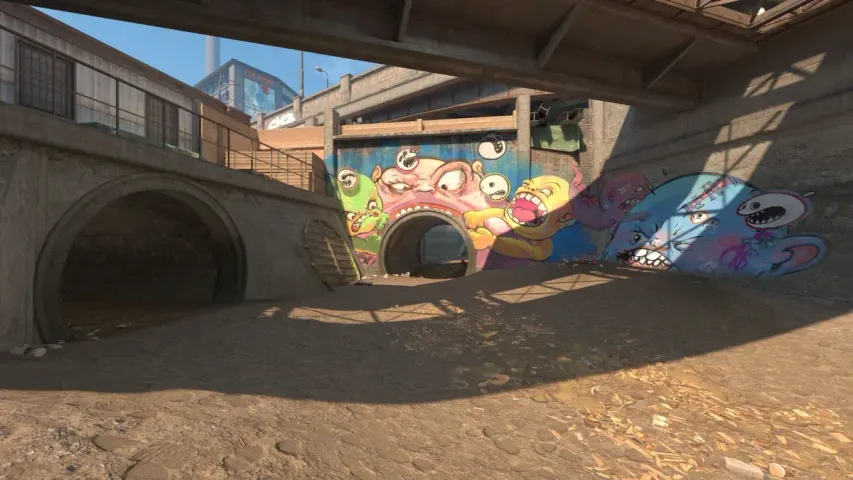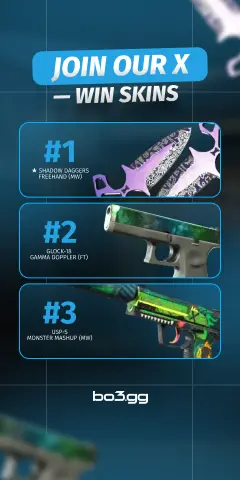
Overpass
The Overpass map in Counter-Strike 2 is one of the most outstanding and innovative maps in the game's arsenal, offering players a unique blend of strategic gameplay, technical skill and teamwork. Since its introduction, Overpass has earned a special place in the hearts of players and has become an indispensable part of the professional Counter-Strike esports scenario.
History of the map
Overpass has a rather short history compared to other maps that are included in the official map pool of competitive Counter-Strike. Since it first appeared in Counter-Strike: Global Offensive. But in CS2 we see almost the same map, which has only been slightly changed visually.
Valve Corporation worked on the map's development, and Lydia Zanotti was the head of the map's port to CS2.
Geographical Location and Main Theme
The Overpass map takes place in an urban European setting, more specifically Berlin, Germany. Players find themselves in the area of a water canal and an overpass, which adds a special atmosphere to the picture. This choice of location not only gives the map a unique look, but also affects the strategies and tactics used by teams.

Goals and tasks
In Overpass, as in other bomb scenario maps, the terrorists have two targets to attack: Point A, where the homing missile truck is located, and Point B, the bridge support. Special forces, accordingly, need to protect these key points, prevent the planting of a bomb or have time to defuse it.
Specifics Maps and Gameplay
Overpass differs from other Counter-Strike 2 maps in its vertical layout and multiple multi-level positions, which requires players to take a non-standard approach to movement and combat. The parkland and overpass provide unique opportunities for ambushes and flanking maneuvers, making each round unpredictable.
Interesting Facts and Easter Eggs
- The TV tower visible on the map is the Berlin TV tower on Alexanderplatz, adding realism to the map.
- The map features several cultural and historical references, including a musical Easter egg from Portal 2 and graffiti commemorating a famous moment with player Olof "olofmeister" Kajbjer.
- After Fnatic's stunt, a sign appeared on the map referencing this event, demonstrating the developers' attention to the player community.
- Counter-Strike had a funny easter egg with ATMs spitting out dollars instead of euros, which was corrected in subsequent versions of the map.
Strategic Diversity
Overpass is renowned for its balance and capabilities for a variety of strategies for both terrorists and special forces. The map offers multiple routes for attack and defense, making each match unique. A team's ability to quickly adapt to enemy actions and effectively use all available resources is often the key to victory.
Impact on eSports
Since its addition to the competitive map pool, Overpass has been home to many memorable matches and moments in Counter-Strike history. Its unique features and balance make it one of the favorite cards among both amateurs and professionals, significantly influencing the strategies and approaches to play at the professional level.
In conclusion, Overpass is not just a map in Counter-Strike - it is a whole world full of strategies, stories and unforgettable moments. Its complexity and richness make it one of the most interesting and sought after cards in the gaming community.

In the world of Counter-Strike: Global Offensive (CS:GO), the Overpass map witnessed one of the most iconic and controversial moments in esports history known as the "Fnatic boost". This exploit not only revealed the depth of strategic thinking that players can bring to the game, but also caused significant changes to tournament rules and the map itself.
Historical moments
The trick of the "Fnatic boost" exploit was to use a technique known as "pixel walking", where one player would stand on an extremely small pad (pixel), almost invisible on the ground, allowing him to be lifted to a height with the help of two other players. This location was located near the barrier near the crashed truck on site A. The top player could see through the invisible walls and follow the movements of the terrorist team heading to site B without putting themselves in danger. Since this position was not available in standard ways, its use was recognized as an exploit at the DreamHack Winter 2014 tournament and was fixed in the patch dated December 4, 2014.

Historical Moments
The name "Fnatic boost" comes from the quarterfinal match at DreamHack Winter 2014 between Team Fnatic and Team LDLC.com. After the first two maps the score was 1:1. Halfway through the final map, Overpass, LDLC was leading 12-3. Switching to the counter-terrorist side, Fnatic used this exploit and won the game. After this, an official protest was filed, which was accepted for consideration. Before the start of the semi-final matches, it was decided that the game would be replayed. However, Fnatic refused to replay, thereby losing the victory to the LDLC team, which eventually won the tournament.
Consequences and Changes
This incident not only brought attention to the importance of clearly defining the rules and possible exploits in esports, but also highlighted the need to thoroughly test cards for potential vulnerabilities. Following the Fnatic boost, the developers made changes to the Overpass map to prevent similar exploits in the future, as well as increased enforcement of rules during eSports tournaments.
This episode left a significant mark on the history of CS:GO, reminding us of the fine line between creative use of the game space and unacceptable exploits. "Fnatic boost" has become an example of how innovative, albeit controversial, strategies can influence the outcome of competition and even lead to changes in the game itself.
Positions on the map

Article info
Wiki
Upcoming Top Matches
Latest top news



